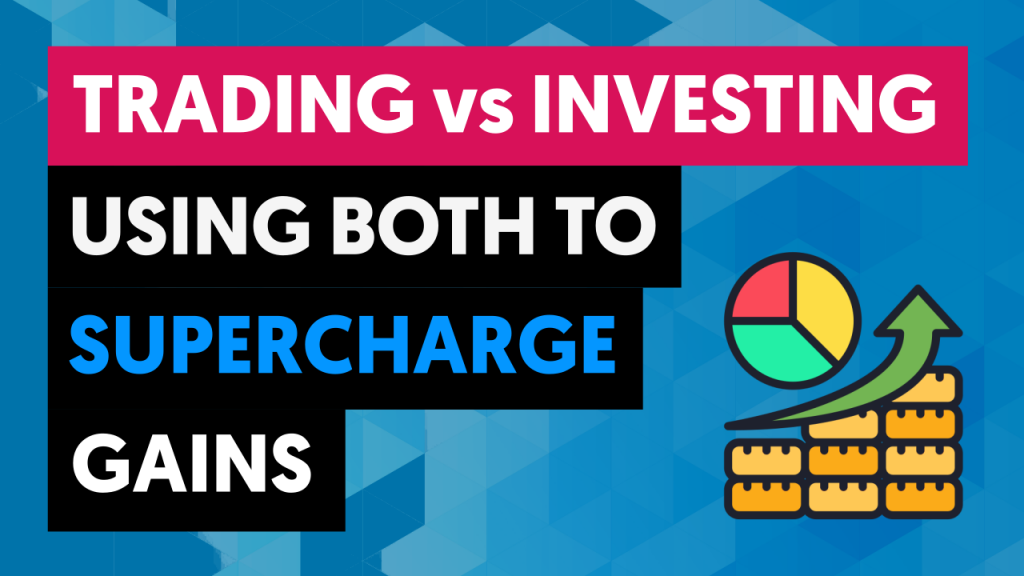
Trading and investing are often confused as being the same thing.
Although they co-exist in the same ecosystem, they are actually two very different activities with different goals.
One is used to make you money, the other is used to protect your money (and make more money along the way).
Confused?
Let me explain.
What is Trading?
Trading is the most active way of playing the financial markets.
You’re required to have a good amount of knowledge in order to try to time the market in an accurate way.
Typically this is done using technical analysis with the help of indicators, drawing trendlines, pivot points, resistances, supports, Fibonacci…
The good part is that it gives you the potential to make a bigger amount of money in a shorter period of time.
Why?
Because trading is typically done with leverage, using a margin account.
This means that your broker lends you money to trade, and the profits are all yours.
The bigger your account, the more money you can borrow for each trade.
What is your trading profile?
As a trader, you have a profile, or a trading style, depending on how long do you like to hold your trades.
Here are the different types of traders:
- Scalping trader: The fastest type of trader. Typically holds the trades from a few seconds to a few minutes.
- Day trader: Opens and closes trades within the same day. It usually holds its trades for a few hours.
- Swing trader: Trades on higher time frames than the previous ones. Time frames from H1 to the Daily are good to swing trade. Typically swing trades are held from two to several days.
Do you identify yourself with different types of profiles?
That’s fine and normal.
I personally do too.
For that reason, I also like to use different trading accounts.
One for each trading style.
It helps me to understand what I’m better at and where should I put my main focus.
Still not decided if trading is for you instead of investing?
Here are some important pros and cons of trading:
Trading pros
- The use of leverage gives you the potential to get bigger rewards with smaller accounts.
- You gain more experience because you trade more often than when investing only.
Trading cons
- By using leverage you are borrowing money from your broker, which will make you pay overnight fees/interest rates when you don’t open and close your trades within the same day.
- There’s a bigger risk of having substantial losses if you get an overnight or weekend gap and you’re using a lot of leverage.
What is Investing?
Investing is the “slow” way of building wealth over time.
It involves buying financial assets regularly, either a portfolio of stocks, ETFs, bonds, or even new markets like cryptocurrencies and letting them appreciate over time.
By slow, I mean, waiting a long period between the time that you open your trade and the time that you close it.
Investors’ horizons to profit can go from months to years or even decades.
And for this reason, timing the market is not very important.
Instead…
Simple strategies, like the dollar cost average (DCA) strategy, tend to work very well.
Now you’re asking…
What’s the Dollar Cost Average (DCA) strategy?
Simple…
The dollar cost average (DCA) strategy removes all the pressure of trying to time the market accurately.
First, you choose your favorite stocks or crypto coins.
Then you make the first purchase.
Just a small amount, we are investing, we don’t go all-in at once!
Now you already have your feet in the water.
From now on, it’s just repetition.
Every month, you take part of your savings and you purchase more of your stock or coin.
And then repeat every month, every week, every quarter…
It doesn’t matter when, as long as you do it the same way all the time.
Regardless of the price.
Now you’re asking…
“What if I’m buying at a peak?”
It doesn’t matter.
When you keep buying regularly, all the volatility is absorbed.
Look at this chart of Apple:
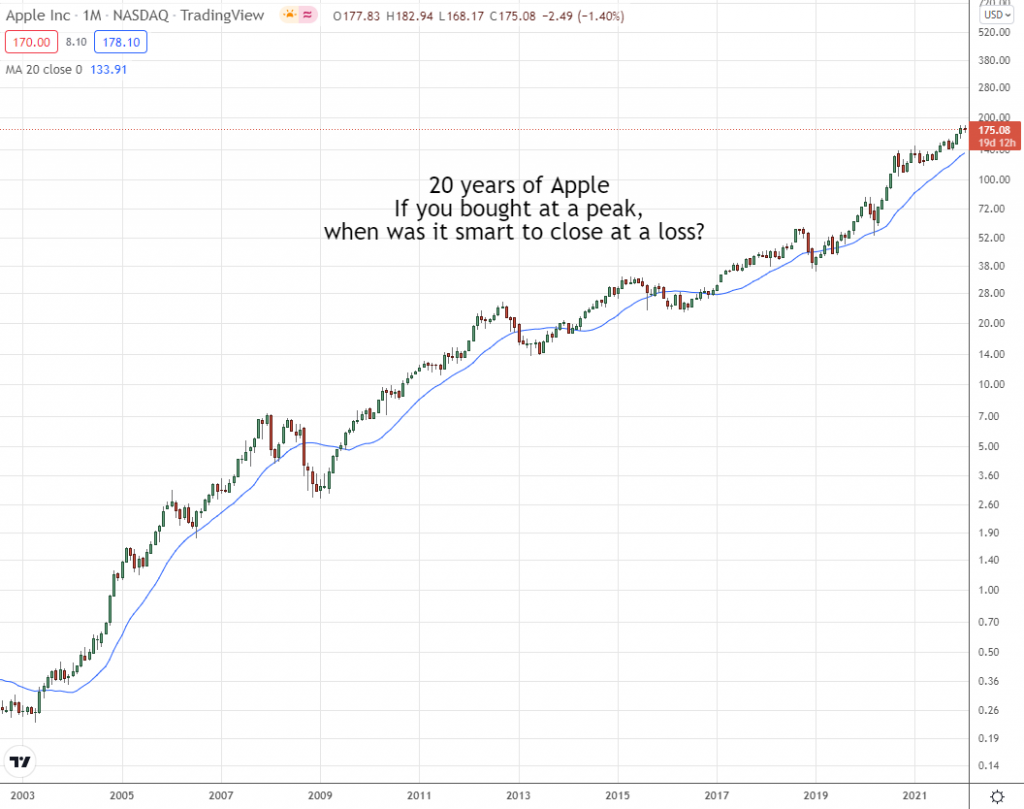
Would you be regretted if you started accumulating at any peak of the last 20 years?
Even if you started right before the 2008 collapse.
How big would be your returns several years later?
“But don’t I ever stop?”
It depends…
Long-term investments are frequently supported by fundamental analysis.
As long as the fundamentals that made you choose your stock or coin are intact, keep holding and adding.
“What if I don’t believe in that company anymore?”
Well…
If you don’t believe it, then it seems that you lost the reasons that made you invest initially.
Probably that’s your time to get out.
Pro tip
Never invest in something that you don’t believe and don’t understand.
“But can’t I use technical analysis for investing long term?”
Sure!
The same technical analysis done by active traders can be used to invest too.
I find that a mix of both is ideal.
Still not sure if you have an investor profile?
Here are a few investing pros and cons:
Investing pros:
- Timing the market is not as important as when trading actively.
- It doesn’t absorb all your time, you may only need to watch the markets once a week or once a month.
Investing cons:
- You need nerves of steel to keep your positions open during temporary bear markets.
- Since you don’t use margin, your buying power is smaller, and decent profits won’t typically appear in a short-term period.
Trading and Investing Myths
Myth #1 – You need a lot of money to trade or invest
This may be true when it comes to day trading stocks using a US broker, where you need a minimum amount of $25 000.
But besides that…
You can trade almost everything that you want with a small amount of capital.
From forex to futures, to stocks, or even cryptocurrencies.
A small $10 amount may be enough to place some trades, buy some cryptos, or even stocks.
And with the rising number of brokers accepting purchases of fractional shares, you can easily invest in a $300 stock using a much smaller capital.
Myth #2 – You’re too young or too old to start trading or investing
You’re never too young or old to do almost anything in life.
I already taught traders aged from 18 to 70+ years old.
Of course the earlier you start, the more time your money has to grow.
But as long as you really want it and it makes you happy just go for it.
Myth #3 – You must buy low and sell high
Ok, buying low and selling high is the ideal investing scenario.
But…
What do you do on markets that go up for decades?
Will you just let them go while you are trying to catch falling knives elsewhere?
Often, buying high and selling higher gives excellent returns.
And at the end of the day, what you want is to be exposed to a market that is recurrently going up.
Trading vs Investing in Stocks: Putting your profits to grow
The biggest enemies of wealth are inflation and taxes.
What do you do with your day trading or swing trading profits?
Straight to your bank account, I guess…
That’s fine, as traders we need money to pay our bills the same way as any other person.
And what about the money that you are able to save from those profits?
Leaving it sitting in a bank account, and gaining interest close to zero is not a good option.
You’re just losing buying power every single day due to inflation.
Literally being robbed legally.
The solution?
Invest your money in something that at least beats inflation.
The stock market is a good option.
Look at Amazon, how well does it perform over time?
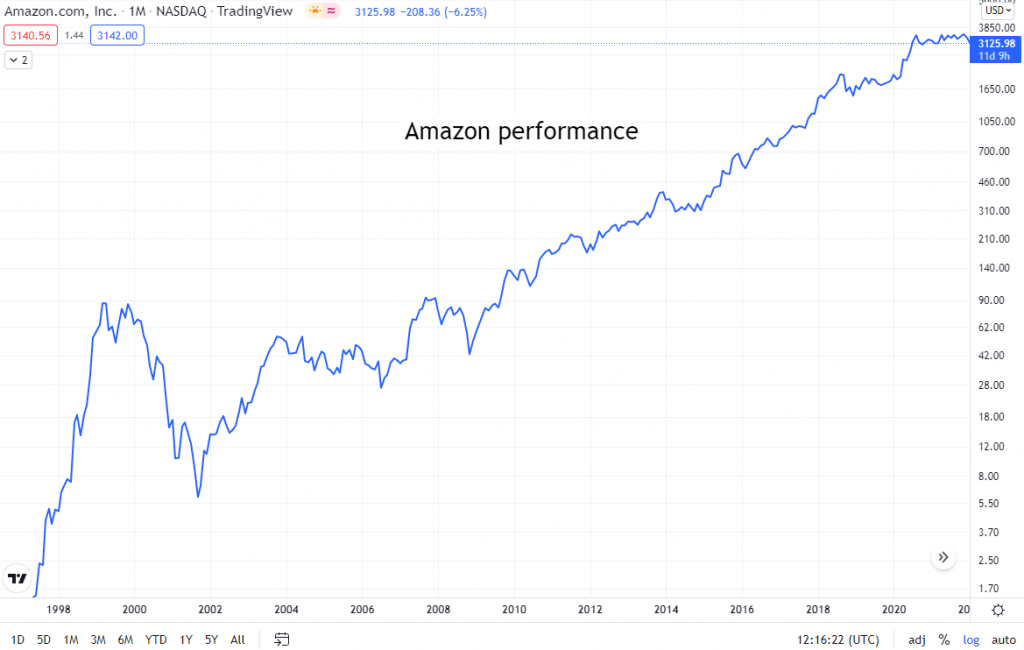
Would you rather have your money parked there?
Or on your bank account losing value over time?
I guess the choice is obvious.
What kind of stocks do you want to hold?
- Strong and well-established companies with plenty of good history
- Good fundamentals
“Oh, but I have so much fear of choosing the wrong stock.”
Don’t worry, I got you covered.
The truth is, we never know what’s going to happen with any particular stock or market.
But we can take good guesses if we have knowledge.
Or if we don’t have it…
We can have someone choose for us.
A stock advisor can be an option, but…
You want to be independent, right?
ETFs are a good solution for that.
You can simply put your money on an ETF that follows the S&P500 index or Nasdaq.
Historically they tend to over-perform inflation and grow over time.
Look at 40 years history of the S&P500.
How well does it look?
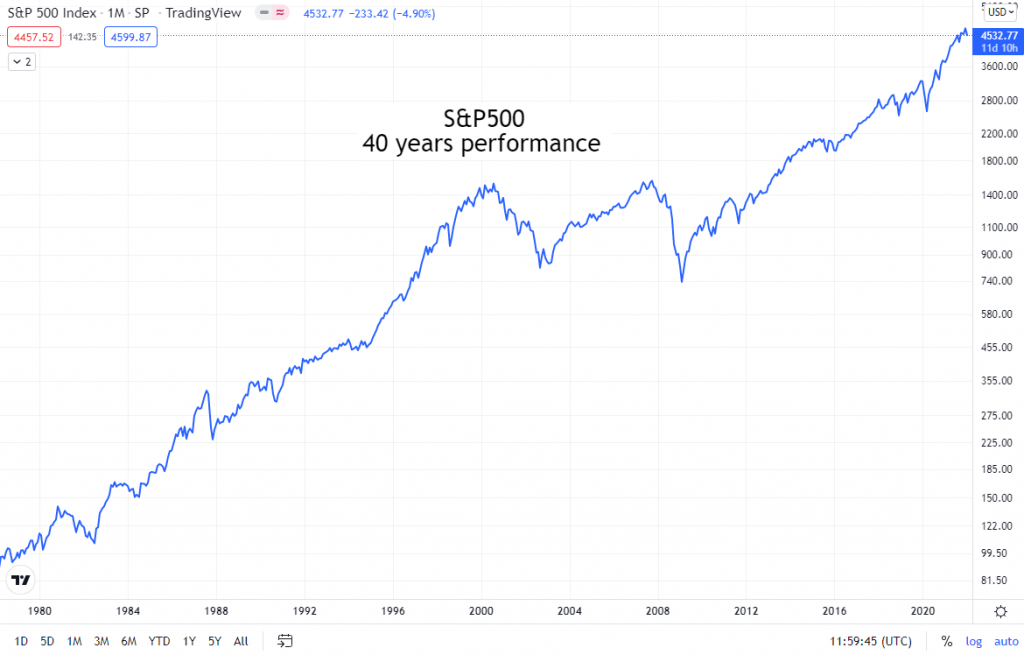
Although quality companies and good ETFs tend to go up with time, they also have corrections and temporary bear markets.
At some point in your life, you’ll see them appearing.
The thing here is…
You need to look into the future.
Long-term future.
If the fundamentals that made you take any particular investment didn’t change, then it may be just a matter of time until the recovery starts.
And the best part?
Those dips are the best to purchase more at cheaper prices.
Trading vs Investing in Cryptocurrencies: Multiplying your buying power
So, you’re a crypto investor.
You want to multiply your money to accumulate the most of your favorite coin(s) to hold/invest long-term.
Whether you like Bitcoin, Ethereum, Cardano, Solana, or Dogecoin, it doesn’t matter.
The strategy is the same for any cryptocurrency.
Let’s say that you are accumulating the original one, Bitcoin.
You have 2 options:
- Investing passively: just buying Bitcoin and letting it run.
- Investing actively: trading to multiply your money and be able to accumulate bigger amounts of Bitcoin.
Do you like the second option?
Nice, here are the steps to follow…
Step 1 – Find a cryptocurrency that shows strength against the coin that you want to accumulate
How do we do this?
Simple!
So, in this example, we want to accumulate Bitcoin to invest long-term.
Let’s open charts of other cryptos against Bitcoin and analyze them.
We want to see the price increase against the Bitcoin price.
This is the same as saying that we want to see an uptrend already established.
Or even better, the early start of a bull market.
I like to use moving averages to detect trend changes.
The break of a moving average to the upside is a potential signal of an uptrend starting.
And here’s an example in the ETH/BTC chart:
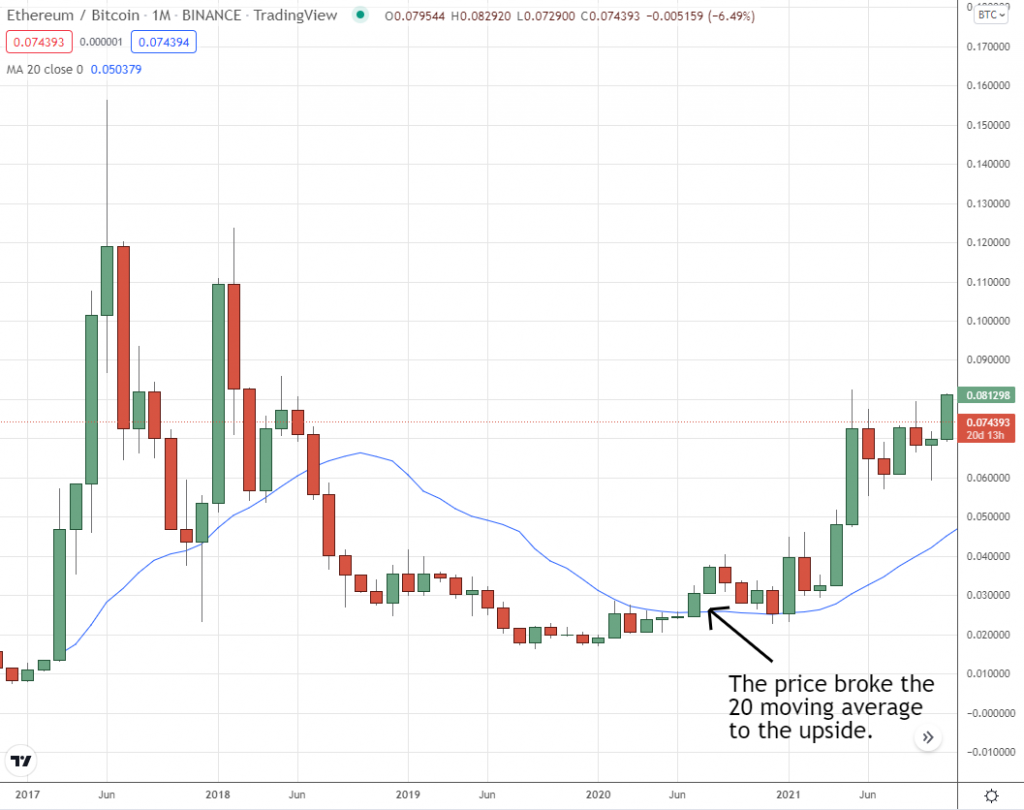
We just found our uptrend against Bitcoin starting, now let’s move on to the next step.
Step 2 – Wait for an entry pattern at the right location
Ok, we are above the moving average.
Now let’s wait for the best time to enter.
We need two things:
- First, wait for the price to get close to the moving average
- Second, wait for a rejection from the moving average
And we got that a few candles later.
In this example, a bullish engulfing pattern appeared.
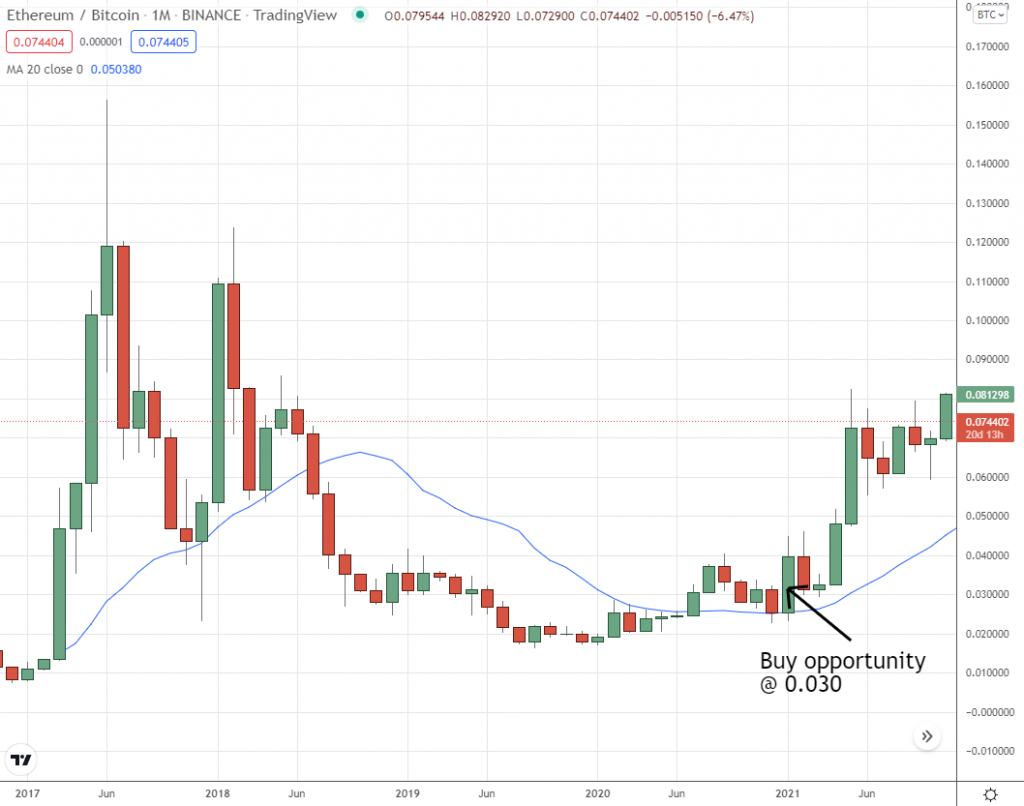
That’s your trigger to go long.
Now we go to the last step.
Step 3 – Wait for a push away from the moving average
Moving averages act as elastics.
They tend to throw the price back every time that they are touched.
Your goal will be to close your trade when the price makes a leg to the upside.
Just before it starts dropping to meet the moving average again.
The simplest way is to simply wait for a move that pushes the price away from the moving average.
That’s your trigger to close the trade.
Pro tip:
If your analysis shows more upside potential you can hold your trade for longer time or keep buying the pullbacks and selling the rallies.
Here’s our example, selling at the end of the next leg after our entry:
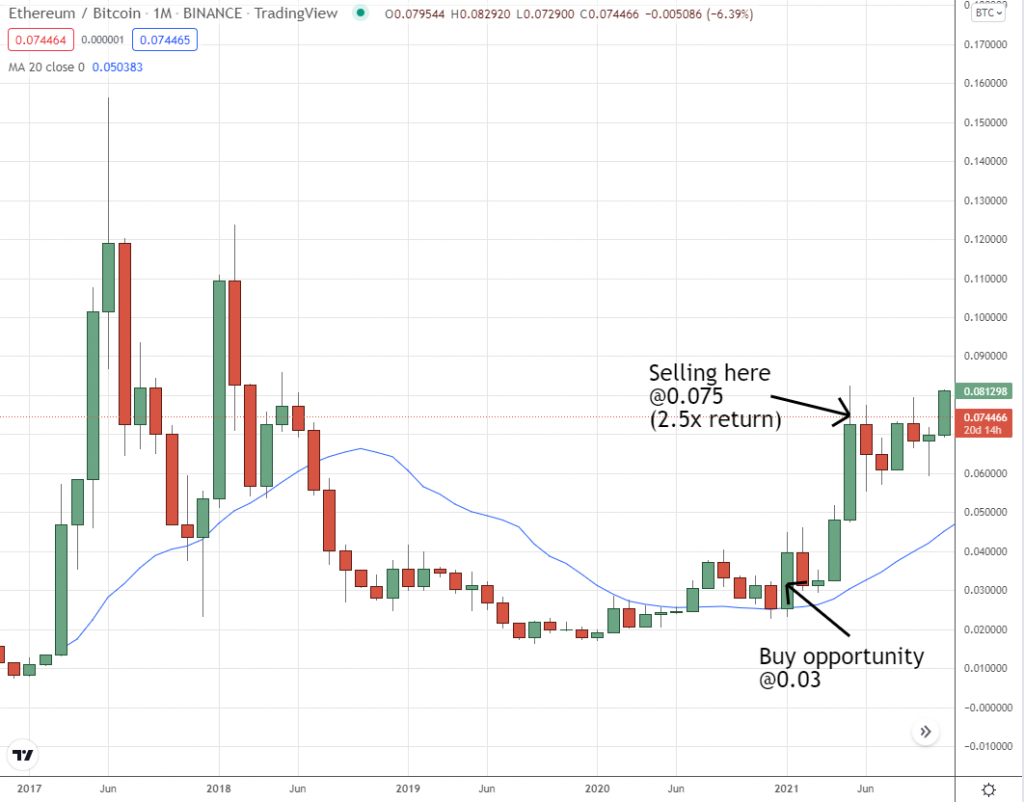
Result?
You just multiplied your buying power.
How?
Let’s say that you spent $1000 buying Ethereum.
At the time of the close, your Ethereum was worth 2.5x more Bitcoin than when you bought it.
Congratulations, you just used $1000 to buy $2500 worth of Bitcoin!
Here’s what you learned today
- Trading is the most active way of “playing” financial markets. It’s often used to generate recurrent income in short periods of time.
- Investing is an activity used to protect your wealth from inflation as well as slowly grow it over time.
- The stock market is a great way to invest your savings, especially if you opt to invest in mature companies with strong fundamentals.
- Cryptocurrencies can be a great alternative to investing your money. Taking some short-term plays in more volatile coins has the potential to generate an extra income that you can use to accumulate more of your favorite coin.
Now I want to hear from you.
What other ways do you know to protect your wealth and make it grow over time?
Let me know below in the comments.


